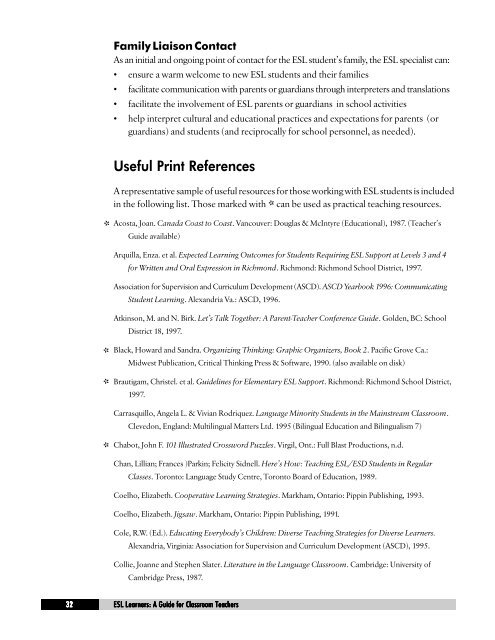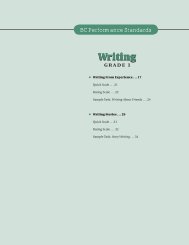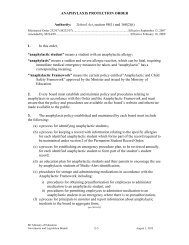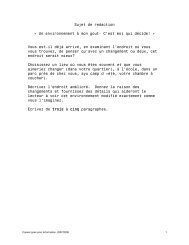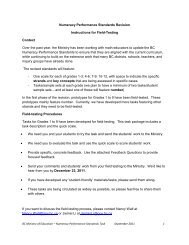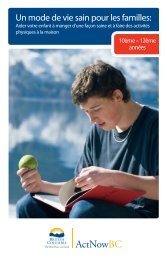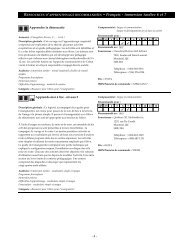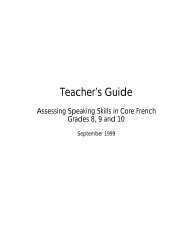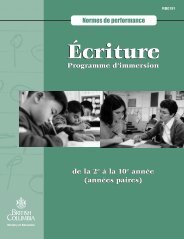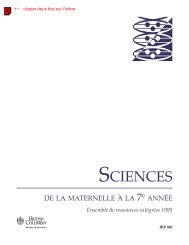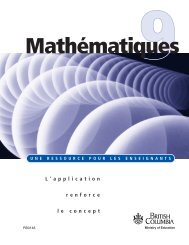A Guide for Classroom Teachers - Education
A Guide for Classroom Teachers - Education
A Guide for Classroom Teachers - Education
Create successful ePaper yourself
Turn your PDF publications into a flip-book with our unique Google optimized e-Paper software.
32<br />
32<br />
*<br />
*<br />
*<br />
*<br />
Family Liaison Contact<br />
As an initial and ongoing point of contact <strong>for</strong> the ESL student’s family, the ESL specialist can:<br />
• ensure a warm welcome to new ESL students and their families<br />
• facilitate communication with parents or guardians through interpreters and translations<br />
• facilitate the involvement of ESL parents or guardians in school activities<br />
• help interpret cultural and educational practices and expectations <strong>for</strong> parents (or<br />
guardians) and students (and reciprocally <strong>for</strong> school personnel, as needed).<br />
Useful Print References<br />
A representative sample of useful resources <strong>for</strong> those working with ESL students is included<br />
in the following list. Those marked with * can be used as practical teaching resources.<br />
Acosta, Joan. Canada Coast to Coast. Vancouver: Douglas & McIntyre (<strong>Education</strong>al), 1987. (Teacher’s<br />
<strong>Guide</strong> available)<br />
Arquilla, Enza. et al. Expected Learning Outcomes <strong>for</strong> Students Requiring ESL Support at Levels 3 and 4<br />
<strong>for</strong> Written and Oral Expression in Richmond. Richmond: Richmond School District, 1997.<br />
Association <strong>for</strong> Supervision and Curriculum Development (ASCD). ASCD Yearbook 1996: Communicating<br />
Student Learning. Alexandria Va.: ASCD, 1996.<br />
Atkinson, M. and N. Birk. Let’s Talk Together: A Parent-Teacher Conference <strong>Guide</strong>. Golden, BC: School<br />
District 18, 1997.<br />
Black, Howard and Sandra. Organizing Thinking: Graphic Organizers, Book 2. Pacific Grove Ca.:<br />
Midwest Publication, Critical Thinking Press & Software, 1990. (also available on disk)<br />
Brautigam, Christel. et al. <strong>Guide</strong>lines <strong>for</strong> Elementary ESL Support. Richmond: Richmond School District,<br />
1997.<br />
Carrasquillo, Angela L. & Vivian Rodriquez. Language Minority Students in the Mainstream <strong>Classroom</strong>.<br />
Clevedon, England: Multilingual Matters Ltd. 1995 (Bilingual <strong>Education</strong> and Bilingualism 7)<br />
Chabot, John F. 101 Illustrated Crossword Puzzles. Virgil, Ont.: Full Blast Productions, n.d.<br />
Chan, Lillian; Frances )Parkin; Felicity Sidnell. Here’s How: Teaching ESL/ESD Students in Regular<br />
Classes. Toronto: Language Study Centre, Toronto Board of <strong>Education</strong>, 1989.<br />
Coelho, Elizabeth. Cooperative Learning Strategies. Markham, Ontario: Pippin Publishing, 1993.<br />
Coelho, Elizabeth. Jigsaw. Markham, Ontario: Pippin Publishing, 1991.<br />
Cole, R.W. (Ed.). Educating Everybody’s Children: Diverse Teaching Strategies <strong>for</strong> Diverse Learners.<br />
Alexandria, Virginia: Association <strong>for</strong> Supervision and Curriculum Development (ASCD), 1995.<br />
Collie, Joanne and Stephen Slater. Literature in the Language <strong>Classroom</strong>. Cambridge: University of<br />
Cambridge Press, 1987.<br />
ESL ESL Learners: Learners: A A <strong>Guide</strong> <strong>Guide</strong> <strong>for</strong> <strong>for</strong> <strong>Classroom</strong> <strong>Classroom</strong> <strong>Teachers</strong><br />
<strong>Teachers</strong>


